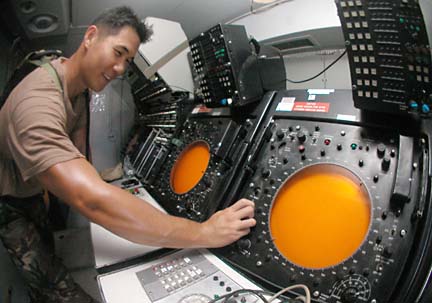
CRAIG T. KOJIMA / CKOJIMA@STARBULLETIN.COM
Members of the 297th Air Traffic Control Squadron based at Kalaeloa returned from Diego Garcia, in the Indian Ocean, on June 29 after being deployed for 3 1/2 months. Master Sgt. Maika Chang examines some of the squadron's radar equipment in a trailer.
Guard air
controllers returnA Hawaii squadron guided raids on Iraq
by B-52 bombers based in Diego Garcia
When Kawai Arakaki took a break from his job as a respiratory therapist at Pali Momi Medical Center, he found himself directing flight operations for B-52 bombers participating in the latest Iraqi war.
Arakaki, a 1986 Kamehameha Schools graduate, always wanted to be a pilot, but by the time he decided to join the military six years ago he was too old for flight school.
Instead, he signed up with the Hawaii Air National Guard and became an air traffic controller with the 297th Air Traffic Control Squadron, based at Kalaeloa.
On March 8, Senior Airman Arakaki and 23 other members of the 297th ATCS were placed on active duty in anticipation of another war in Iraq and sent to Diego Garcia, an air base on a narrow tropical jungle reef in the Indian Ocean, about 1,000 miles south of India. Diego Garcia is approximately 3,300 miles from Baghdad, which translates into a 10- to 12-hour round trip.
Maj. Roy Schindler, a Louisiana reservist who was assigned to lead the Hawaii air traffic controllers and support maintenance personnel, said during the 3 1/2 months the unit was deployed, it ran 3,500 missions for the 40th Expeditionary Wing, which has flown B-52 bombing raids out of Diego Garcia since the Sept. 11, 2001, terrorist attacks.
But Arakaki said that there wasn't much of a difference from directing the air traffic at Kalaeloa.
"We treat all aircraft alike, even if it was a B-52," said Arakaki when asked to compare flight operations over the Hawaiian Islands and those during the recent war.
"We have flight separation rules that apply to all aircraft," he added as his unit began the task of reassembling at Kalaeloa the radar vans, antennas and other equipment that they had taken with them. The 23 men and one woman in the 297th ATCS returned to the islands on June 29.
This was Master Sgt. John Murakami's second wartime deployment. In 1997, he was one of 31 Hawaii Air Guard traffic controllers who were sent to Taszar Air Base in Hungary to support the United Nations air actions over Bosnia. They were then the first in the Hawaii National Guard to be called to active duty since the Vietnam War.
For nearly five months in Hungary, the air traffic controllers handled military aircraft flying to and from Bosnia, including Russian-made MiG-29 jet fighters.
Murakami, a 1982 Mililani High School graduate, said the biggest difference between the 1997 wartime deployment and this year's action was equipment. "We didn't deploy with all our generators and vans in 1997 and we didn't have to set up the equipment," Murakami said.
When the traffic controllers left Hawaii in March, they were required to take all their radar vans and support equipment. "We accompanied all of it on a C-17 (jet transport)," said Murakami, 38. "We also had to set up everything."
Normally, it takes the Hawaii Air Guard controllers less than 36 hours to become operational. However, in this case Murakami said the unit took a little longer to make sure everything was working properly.
Once the unit's two radar vans were placed, Murakami, who has been a traditional citizen soldier for 17 years, said "we were operational continuously, running eight-hour shifts with three crews."
Sgt. Rosa Mattimoe, a radar maintenance technician, said there wasn't much to do when she wasn't working. "I worked out and I slept," said Mattimoe, who has been in the Hawaii Air Guard for more the seven years.
Although she described her first active duty assignment as "a great experience," Mattimoe, 32, said it was hard being away from family -- her husband, a cat and a dog -- who live in Ewa Beach.
Schindler, who normally commands the Louisiana's 259th Air Traffic Control Squadron, said that 60 percent of the Air Force's air traffic controller resources are in the Air National Guard. "We plugged in seamlessly into the 40th Air Expeditionary Wing," he added. "In fact, we not only plugged in seamlessly, but in the end the wing didn't want to release us."
"I was proud to go," said Arakaki, who is studying to be a nurse. "At first there I was, hesitant like everyone else. But you had to focus on the mission. It was a different scene ... nothing like treating patients every day, but that is why I enlisted -- to do something different."
